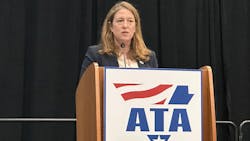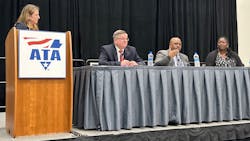FMCSA leader outlines strategy, addresses trucking safety loopholes at ATA’s MCE
SAN DIEGO—Robin Hutcheson, the first Senate-confirmed administrator of the Federal Motor Carrier Safety Administration in three years, is on a journey to better understand the industry’s needs. On Oct. 22, she used American Trucking Associations’ 2022 Management Conference & Exhibition not only as a platform to outline the agency’s strategic goals but as a stand to address attendees’ questions and concerns.
Over the last 10 months or so, FMCSA has laid out specific safety, economic, equity, and climate goals, which Hutcheson said are backed up by policy resources under U.S. Transportation Secretary Pete Buttigieg’s National Roadway Safety Strategy. This strategy, she added, which focuses on roadway fatalities and serious injuries, gives FMCSA provisions and investments to help the agency reach its ambitious goal of zero fatalities.
Some of these provisions, outlined in the Biden administration’s Infrastructure Investment and Jobs Act, include the Women of Trucking Advisory Board, Safe Driver Apprenticeship Program, and Biden’s Trucking Action Plan.
“Equity is a priority for us,” Hutcheson said of the Women of Trucking Advisory Board. “We’ve heard about safety issues for women, including sexual violence and harassment. It keeps women from working as drivers. We are very hopeful for the work of this board and to help women pursue careers in trucking; to enhance scholarship opportunities; and to enhance industry-related training, mentorship, education, and outreach programs.”
When it comes to broadening the driver pool, Hutcheson emphasized that health, wellness, and job satisfaction are all directly correlated to safety. She added that FMCSA is currently working on two studies to improve driver job satisfaction: one on compensation and the other on driver detention time.
FMCSA is also updating its Large Truck Crash Causation Study, which hasn’t been updated in two decades, and reincarnating a speed-limiter rulemaking that has received nearly 16,000 comments in the Federal Register.
See also: A primer on trucking issues from an industry heavyweight
“We’re listening and hearing lots of other things that are coming from you that need to shape and focus our work,” Hutcheson told MCE attendees. “One of the things we are hearing so much about is the hardships of truck parking. We know that the difficulties associated with truck parking are disruptive to the supply chain and it exposes drivers to danger. Research shows that driver fatigue contributes to about one of every seven commercial motor vehicle crashes.”
The lack of truck parking has been a top-five issue in the American Transportation Research Institute’s annual Top Industry Issues survey since 2015. ATRI’s 18th annual report, unveiled during MCE just before Hutcheson took the podium, ranks truck parking as the No. 3 issue overall, with drivers ranking it No. 1 on their list for the third straight year.
Last month, FMCSA announced two grant awards for the expansion of truck parking technology in Florida and Tennessee. The agency has awarded more than $1 billion in the two states to better help drivers find parking.
Distracted driving, large truck crashes
During an open Q&A session, Hutcheson and a panel of FMCSA representatives, including Jack Van Steenberg, FMCSA’s executive director and chief safety officer; Earl Adams Jr., chief counsel for FMCSA; and Kala Wright, FMCSA’s director of external affairs, took on a variety of questions from MCE attendees.Ed Nagle, president and CEO of Nagle Cos., asked the panel what FMCSA’s plans are to address distracted driving. “It is the greatest problem and risk for our drivers,” Nagle pointed out. “It is also the most underreported cause of accidents because law enforcement agents don’t have the resources to go to a judge to get a warrant for every accident for use of a cell phone in a vehicle. Our drivers are sick of this and have been involved in multiple accidents because of other people texting and driving. What can we do about that?”
See also: Deterring distracted driving to save dollars and lives
Van Steenberg explained that is something the agency is looking into as it updates the Large Truck Crash Causation Study. The study’s overall purpose is to enhance FMCSA's and state partners’ ability to evaluate crashes involving large trucks and identify emerging trends; monitor crash trends and identify causes and contributing factors; and develop safety improvement policies and programs.
“We are going in real-time, using law enforcement and inspectors, and we are going to have post interviews of drivers, witnesses, and so forth, and we will do an in-depth examination of the report,” Van Steenberg said. “We will have the hard details. If you look at the National Roadway Safety Strategy, we are looking at data and at high crash quarters out there. The bipartisan infrastructure bill gave us a lot more funding to give to our grantees, like state troopers and local police. What we’ve asked them is to identify high-crash locations and put some efforts into those locations to reduce the incidents of crashes.”
Van Steenberg added that technologies such as inward- and outward-facing cameras also could be investigated further.
CSA concerns and loopholes
Paul Enos, CEO of the Nevada Trucking Association, explained that for many carriers, economic viability lives and dies with FMCSA’s safety measurement system, Compliance, Safety, Accountability, which is a perennial top 10 concern in the trucking industry. The 2015 Fixing America’s Surface Transportation Act, known as the FAST Act, included a requirement for a National Academies review of CSA, which was issued in 2017 and included recommendations for improving CSA scoring to better reflect a carrier’s risk profile. FMCSA, however, has yet to implement a new CSA scoring approach.
“Customers are looking at it, insurance companies are looking at it, the trial lawyers are looking at it,” Enos stressed. “When you’re running in states like Nevada and California, you’re going to look good because we have law enforcement agencies that will not only give you violations but will also give you an inspection report. If I am running into Arizona, Utah, or places in the northeast, that’s not the case because of a disparate interpretation of laws. How can FMCSA work with partners across the country to communicate the fact that we need to have a carrot-and-stick approach [for CSA] instead of just the stick?”
Van Steenberg said that in working with agency partners, like the Commercial Vehicle Safety Alliance, FMCSA has been preaching the importance of inspection reports, even if they don’t include violations.
“It’s a constant dialogue that we have with the enforcement agencies throughout the country to assure they are following the Level 1, 2, and 3 inspection protocols, ensuring that we do get the inspection report,” Van Steenberg said. “We want the inspection report and that data.”
Mark Doughty, president and CEO of PrePass Safety Alliance, pointed to CSA’s beyond compliance BASIC, which was intended to reward trucking companies for safety programs that voluntarily exceed regulatory requirements. That safety category was codified by the FAST Act, though never really came to fruition, Doughty noted, adding the industry is now looking into universal vehicle identifier device tracking that would identify the vehicle to roadside inspectors for enforcement and Level 8 inspection solutions.
“Are there any comments that you can share in terms of how that, beyond compliance and different credit for the carriers really doing the right things, can be that carrot as opposed to that stick?” Doughty asked.
Van Steenberg noted that although the beyond compliance BASIC is “a great concept, the dilemma has been figuring out what’s working, how long federal agencies have to assess if it’s working, and then when carriers are credited.
“We regulate 600,000 carriers, so how do we manage that fairly across all the carriers,” Van Steenberg added. “These are some of the challenges that we are addressing. Give us some time, we are not sure we are there right now with how to manage the beyond compliance program.”
Ultimately, Hutcheson said one of her platforms as FMCSA administrator is to close safety loopholes going forward. That, she said, will involve significant technology investments.
About the Author

Cristina Commendatore
Cristina Commendatore is a past FleetOwner editor-in-chief. She wrote for the publication from 2015 to 2023.

